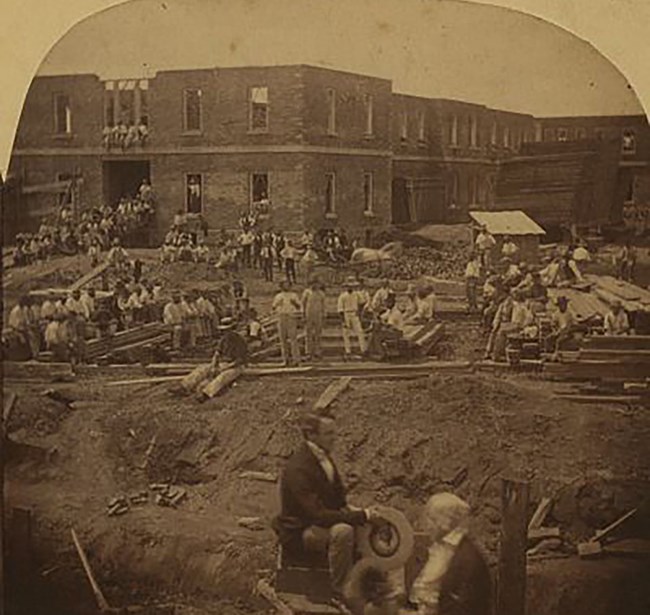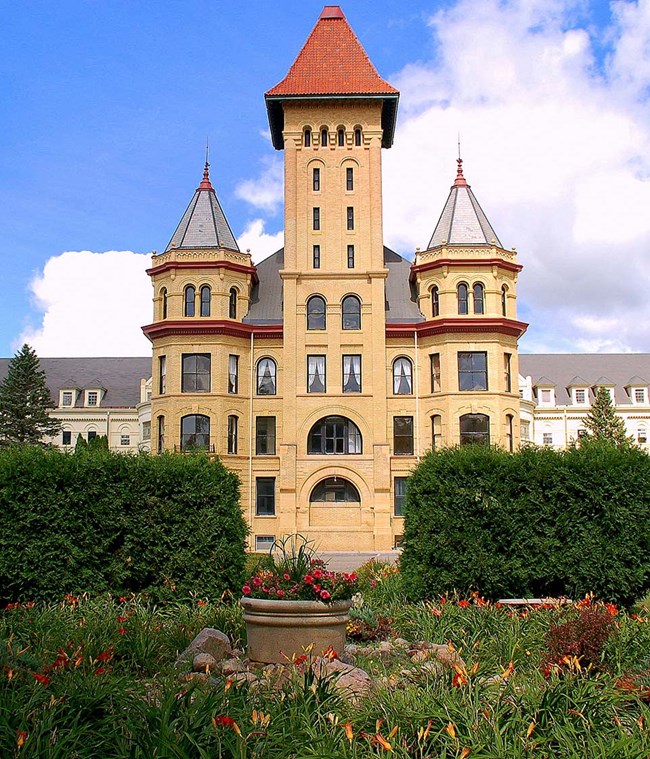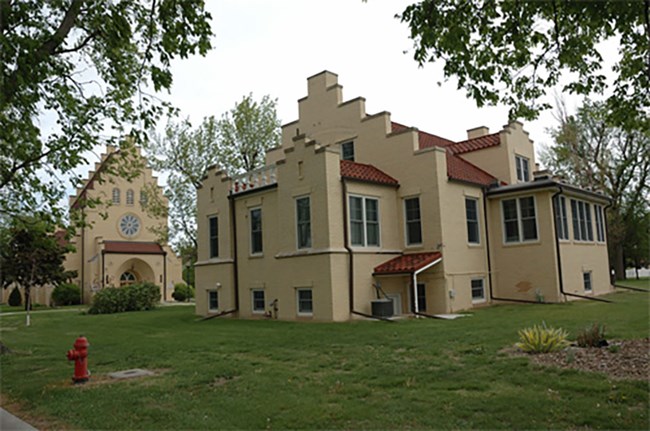Part of a series of articles titled Disability History: An Overview.
Article
Disability History: Early and Shifting Attitudes of Treatment

Detail of a stereograph, collections of the Library of Congress (https://www.loc.gov/resource/ppmsca.09418/).
Before Dorothea Dix and other healthcare reformers advocated for better treatment in hospitals and almshouses, what were the experiences of people with disabilities like in the 1700s and 1800s? How can studying this history help us understand the everyday lives of people with disabilities, their perceptions of themselves and society’s perceptions of them?
In colonial America, caring for people with disabilities was often a town's responsibility. Towns provided poor farms and almshouses as places to house and support those in need. Individuals with disabilities, criminals, and paupers were often lumped under one roof. The superintendents of the Johnson County Poor Farm and Asylum, which opened in 1855, argued that it offered good living and work conditions. However, these facilities were often overcrowded and dirty. They were also unregulated. Men and women lived in the same space with little oversight. Living at a poor farm was typically involuntary. Due to financial constraints or the inability to provide for their relatives properly, families often struggled to care privately for their relatives deemed “insane” or with physical disabilities. When families could not cope with care, these individuals became wards of the state. By the 1800s, inmate numbers swelled. Doctors blamed overcrowding on the rapid development of cities, machinery, and industry. Many physicians of that time believed that industrialization created pressure and stress on individuals. In response, state government took responsibility for these populations and often removed them to the countryside. Groups were divided and placed in institutions that were thought to be specific to their needs. However, individuals with disabilities-- whether physical or cognitive-- were commonly sent to "lunatic" and "insane" asylums.[2]

Photo by Keith Ewing (CC BY-NC-2.0; https://www.flickr.com/photos/kewing/9587097130)

Photo by Grant Landreth, from the National Register of Historic Places nomination.
Religious organizations also supported the concept of moral treatment. The Friends Asylum for the Insane in Philadelphia, founded in 1813, is one such example. Doctors there used a combination of Quaker views and medical science of the era. This was the first private, nonprofit exclusively mental hospital in the US. The Bethphage Mission in Nebraska was another religiously-inspired hospital. The Mission, opened in 1914, followed the work of the Swedish and Augustana Evangelical Lutheran Church. The Friends Hospital, Bethphage Mission, and other religious hospitals are still active today.
Many hospitals stopped practicing this version of moral treatment in the 1900s for a number of reasons. State legislators decided that the cost of these programs was more than they were willing to spend. Hospitals also shut down their farms and workshops. Hospital superintendents instead focused on research and new medical treatments. Electroshock therapy and hydrotherapy were among two new methods. With electroshock therapy, small electric shocks were passed through the brains of patients. Hydrotherapy, or water exercises, were developed to help patients.
Doctors were also influenced by popular ideas of eugenics in the late 1800s and early 1900s. Eugenics is the misguided belief that controlling genetics could improve the human race. Some doctors practiced forced sterilization on persons they deemed unfit, removing their ability to have children. Other physicians also performed lobotomies to cut connections between parts of the brain, believing lobotomies could significantly reduce “mania” or “highly disturbing” behavior. Thousands of lobotomies were performed in the 1940s and ‘50s, though this practice faded in popularity by mid-century. Doctors and healthcare advocates increasingly questioned the effectiveness of surgery, instead opting for medication and other methods of care to treat patients.
From the 1960s to the 1990s, many hospitals and psychiatric institutions shut down, giving way to state-funded programs and services in place of these hospitals. These services strive to address an individual’s needs on a case-by-case basis, rather than aiming to “cure” patients with blanket treatments. Changes in treatment of people with disabilities have shifted largely due to the emergence of the disability rights movement in the early 20th century. Individuals’ demands for rights, self-advocacy, and independence have changed the perception of care. The concept, “Nothing about us without us,” which was adopted in the 1980s and ‘90s by disability activists, has altered the decision-making process. Today, there are increased efforts for physicians, caregivers, and people with disabilities to work together to support an individual’s well-being.
Article by Perri Meldon.
This article is part of the Telling All Americans’ Stories Disability History Series. The series focuses on telling selected stories through historic places. It offers a glimpse into the rich and varied history of Americans with disabilities.
References:
[1] Dix, Dorothea, Memorial to the Legislature of Massachusetts. Boston: Munroe & Francis, 1843. Excerpt.
[2] Nomination Form of National Register of Historic Places: Commonwealth of Massachusetts State Hospital and State School System.
[3] Gerald Grob, The State and the Mentally Ill: A History of Worcester State Hospital in Massachusetts, 1830-1920, Chapel Hill: University of North Carolina Press, 1966.
[4] Nomination Form of National Register of Historic Places: Commonwealth of Massachusetts State Hospital and State School System.
Last updated: October 31, 2017
